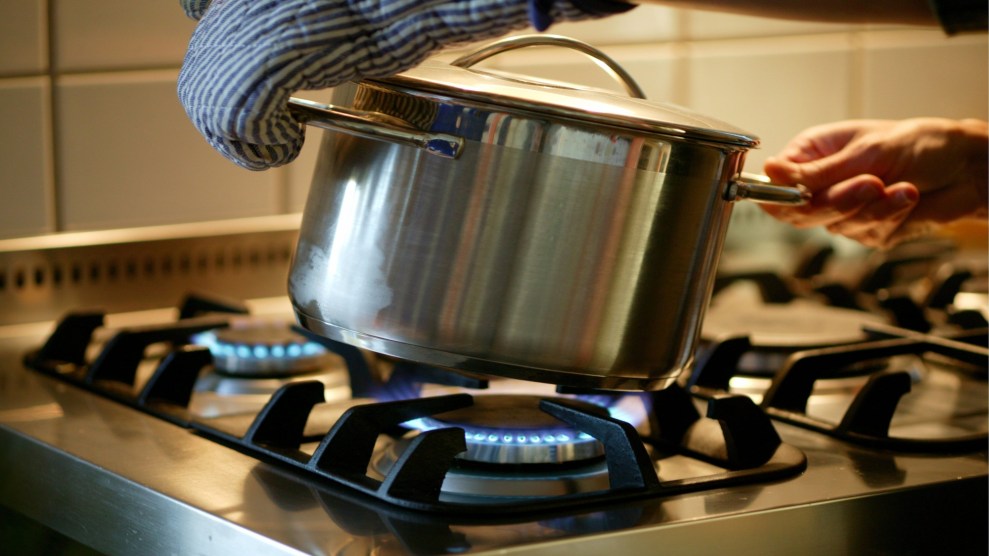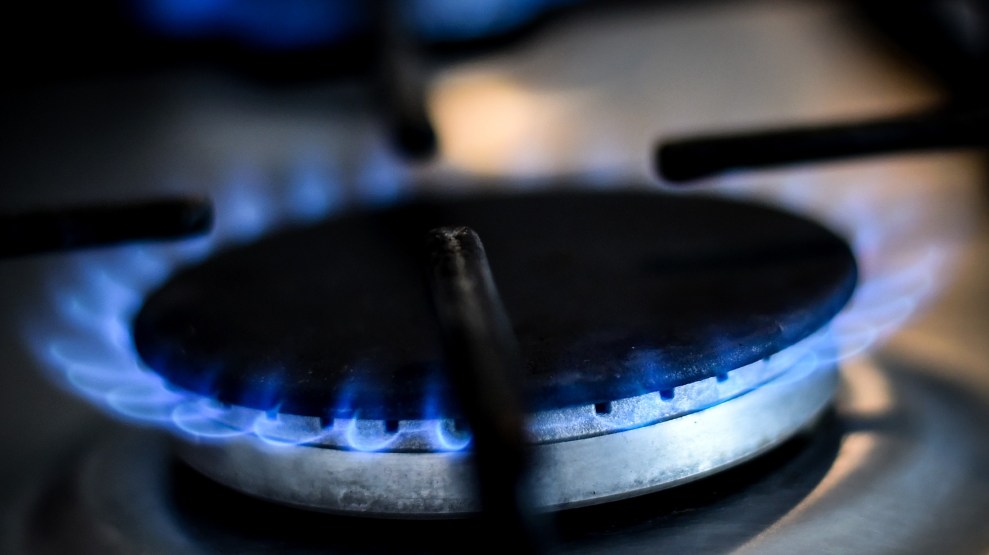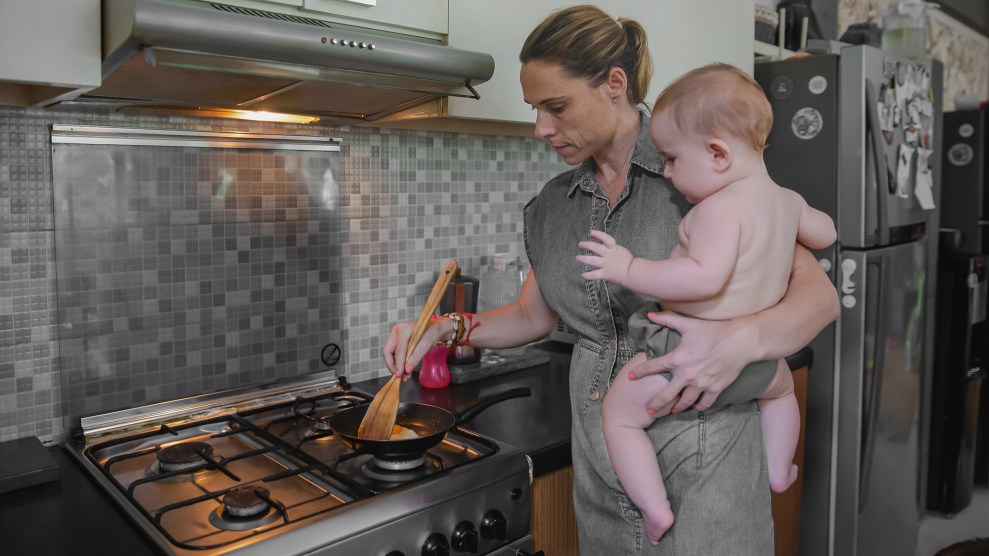
A pot is being taken from the gas cooker. Ulrich Baumgarten/Getty
This story was originally published by ProPublica.
As a climate reporter, I was well aware of the growing concern about the gas stoves in people’s homes leaking dangerous pollutants, like methane, a potent greenhouse gas and explosive hazard; nitrogen dioxide, which worsens asthma; and benzene, which causes cancer. But I was a renter who had no control over my appliances. So I mostly ignored it — until one day last fall when I smelled the rotten-egg odor of leaking natural gas while baking focaccia.
I borrowed a $30 gas leak detector from a friend (a fellow climate reporter, of course). When I turned on the oven in my New York City apartment, the lights for a “significant” leak lit up. My kitchen was filling up with methane. According to the user manual, that meant I should “VENTILATE THE AREA IMMEDIATELY and move to a safe location” in case of an explosion. I opened the windows and ignored the evacuation advice (don’t follow my example), too intent on taking a video of the leak as proof for my landlord before turning off the oven. Then I vented my frustration by panic-texting friends and eating too much focaccia — after cutting it into pieces and baking it in my toaster oven. Luckily, my landlord replaced my faulty stove within days. I made sure to check the new stove (still gas, alas) for leaks after it was installed.
“People still don’t recognize that there are health downsides to cooking with gas in your home,” said Regina LaRocque, a Harvard Medical School professor who does research on medicine and public health. “This is the 21st century, and we have better ways of cooking than over a fire.”
The issue has caught national attention in recent weeks, as the U.S. Consumer Product Safety Commission considers regulating gas stoves. Public health experts and environmentalists have long warned of the risks of gas ranges. One study found that indoor gas stoves were responsible for roughly 13% of childhood asthma cases in the U.S. The American Public Health Association and American Medical Association have urged consumers to transition away from gas.
LaRocque uses a traditional electric coil stove at home. But she and other experts advocated for induction stoves, which use electromagnets to heat up food. These stoves are growing in popularity as consumers choose them for climate, health and safety reasons, though they can cost more than twice as much as a gas range.
The federal Inflation Reduction Act will provide rebates to upgrade to electric or induction home appliances (here’s a Wirecutter guide on that program). Some states, including Massachusetts, offer their own rebates as well.
Induction stoves are much more common in Europe, LaRocque said. That cultural shift has yet to occur in the United States, where more than a third of households use gas stoves. As Mother Jones reported, the gas industry embraced the term “cooking with gas” in the 1930s; an executive even made sure to get it worked into Bob Hope’s comedy routines. More recently, the industry has opposed electrification efforts with lobbying and social media influencers who tout gas as a “super cool way” to cook.
I consulted multiple experts on the hazards of gas stoves and what people can do about them. Their advice boiled down to this: homeowners who can afford it should switch to an induction or electric stove. For renters and others who can’t replace their appliances, the experts provided tips on lowering the health risks.
Methane is a greenhouse gas. The gas that’s piped into your house is virtually all methane. When you burn methane to cook food, it turns into carbon dioxide. But unburned methane trickles out from loose fittings and faulty stovetop igniters. Every pound of methane released into the air is 30 to 86 times more effective at warming the planet than a pound of carbon dioxide.
When researchers analyzed 53 homes in California last year, they found methane leaking from almost every stove. More than three-quarters of that methane came from stoves that were turned off. The act of igniting a burner or oven released additional puffs of methane. If these leaks are consistent across the nation, then annual methane emissions from U.S. gas stoves would equal the greenhouse gas emissions of half a million cars.
These leaks are “pretty much universal,” said Robert Jackson, a Stanford University professor and a study co-author. Jackson, who’s spent more than a decade studying methane leaks from gas wells, pipelines and other fossil fuel infrastructure, said it can be hard to predict where the leak is coming from. Based on the description of the leak in my kitchen, he told me it likely was caused by ignition problems with the oven. Jackson’s research has inspired him to ditch his gas stove, furnace and hot water heater in favor of induction and electric appliances.
“I did not expect to see the high levels of indoor air pollution we saw consistently,” he said. “It strongly motivated me to replace my own stove.”
Large methane leaks can cause explosions. If you smell gas in your home, leave the building and call your gas company. The distinctive rotten-egg odor comes from chemicals that gas companies add to the methane to make it easier to detect, since the gas is naturally odorless.
Some people are much more sensitive to the smell than others, so it’s not a foolproof warning for explosive risk. Eric Lebel, lead author of the methane study Jackson worked on, recalled smelling gas in some of the homes where he did the testing, even though the homeowners couldn’t smell anything. Lebel is a senior scientist at PSE Healthy Energy, a nonprofit science and policy research institute.
Burning natural gas releases nitrogen dioxide, a respiratory irritant. Nitrogen dioxide exacerbates asthma and impairs lung function. The Environmental Protection Agency regulates these emissions from cars and power plants with national air quality standards, but those regulations don’t apply to indoor air.
The Lebel and Jackson study measured nitrogen dioxide and a related compound. They found steadily rising emissions after turning on burners and ovens.
“Simply having a combustion stove in your home is a health risk,” LaRocque said. In poorly ventilated kitchens, nitrogen dioxide levels could exceed outdoor air standards. “It would be like standing behind an idling car, or standing in a smoke-filled room,” she added. “I think if my child had asthma, I would definitely want to intervene.”
Gas stoves leak benzene, a carcinogen that can cause leukemia. In a separate study published last fall, Lebel and his colleagues analyzed gas samples from residential kitchens. Out of 160 samples, all but one contained benzene.
“If there’s a leak from that appliance, it likely contains benzene,” Lebel said. “It’s a rather unavoidable cost of owning a gas appliance.”
Raw natural gas contains a mix of methane and toxic chemicals like benzene, toluene or formaldehyde. Gas companies strip out the impurities before piping the processed gas to homes, but they don’t eliminate all the toxins.
Lebel’s team modeled the benzene concentrations from the leaking stoves and found a handful that failed to meet California’s benzene safety guidelines. They also found traces of other harmful compounds, including toluene, ethyl benzene and xylene, which can cause dizziness, nausea and liver damage. A separate study of gas appliances in the Greater Boston area found benzene in 95% of samples, though at lower levels than Lebel’s study.
Turn on the range hood above your stove. Paul Francisco, associate director of building science at the University of Illinois Urbana, Champaign, suggests cooking on the back burners and using the hood whenever you turn on the stove or the oven. The fans improve ventilation and will pull benzene, methane and nitrogen dioxide outdoors.
However, this only works if the hood connects to the outside of your house. Follow the piping on the hood: If the top of the device goes through the ceiling or the wall, then it should help with air quality.
Another type of range hood, called a “ductless” hood, simply recirculates indoor air. If your hood has grilles or vents on the front, then it’s likely, but not guaranteed, to be ductless, Francisco said. These fans won’t cut down on harmful gases, but they might be able to reduce particulate matter — tiny particles created during cooking, which can cause or exacerbate respiratory illness. A 2014 study found that cooking on induction stoves produced far fewer particles than cooking on gas or electric stoves.
Open a window to improve ventilation. At a minimum, an open window will dilute toxic gases.
If your kitchen is in the upper half of a building, opening the window should draw the contaminants outside as long as there’s no wind and it’s warmer inside than outside, Francisco said. If you live in the lower half of a building, opening a window in the winter won’t be as effective, he said, though any ventilation is better than none.
Get an induction hot plate. If you can’t replace your stove, experts said the next best thing is to buy an induction burner. Here are some consumer guides with reviews of portable hot plates.
During last summer’s heat waves, when I couldn’t fathom lighting a fire inside my kitchen, I did almost all my cooking using an induction hot plate, an Instant Pot and an electric toaster oven. Excessive heat is another reason why some chefs advocate for induction burners.
What about air purifiers? These devices have become more popular as a way to improve air quality and reduce the risk of COVID-19 infections. Most air purifiers won’t have any effect on toxic gases, though they do remove particulate matter, Francisco said. Some specialty models filter out volatile organic compounds, a class of chemicals that includes benzene.
Should I buy a gas detector? There are a number of methane monitors that are designed for consumers, priced from roughly $30 to $200. Some will tell you about the presence of a leak. Others are sensitive enough to detect specific concentrations of methane. You can also find indoor monitors that detect particulate matter for $200 to $300.















